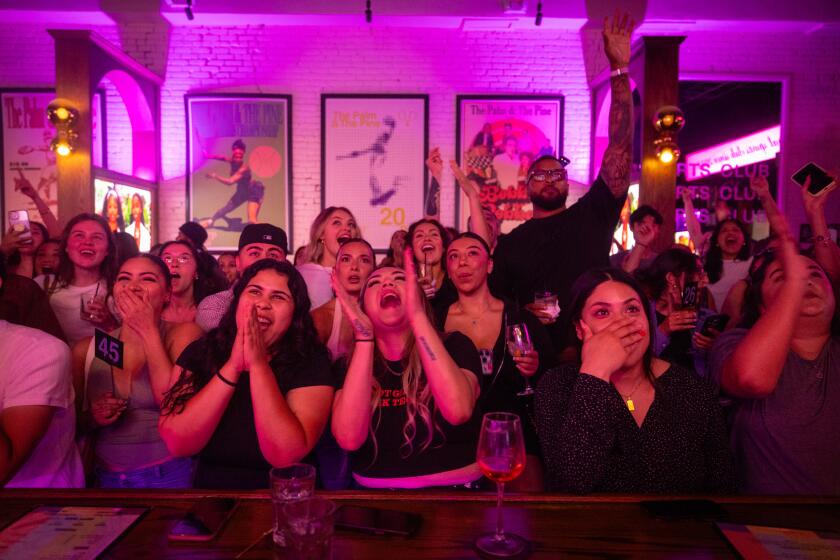Spotlight returns to SAG talks
- Share via
The new contract struck between the Hollywood studios and the American Federation of Television and Radio Artists achieved across-the-board gains for actors, especially for journeyman performers who have seen their incomes squeezed in recent years.
But it is not clear if those gains will be sufficient to mollify leaders of the larger Screen Actors Guild, which resumed negotiations with the studios on Wednesday.
AFTRA’s tentative accord, addressing bread-and-butter economic issues, includes a 13% hike in minimum pay for guest stars and other major role performers. It also doubles the pay actors receive from movies and TV shows sold online and establishes payments for programs that are streamed online.
If its members ratify the agreement, AFTRA would become the second Hollywood union to accept a deal based on the contract negotiated by the directors guild in January. That would probably make it harder for SAG -- which represents the overwhelming majority of performers in prime-time TV and all of those in studio feature films -- to argue that its members deserve significantly better terms.
“This is a challenging time in the entertainment industry, and this was a tough negotiation,” said AFTRA President Roberta Reardon. “Our ability to achieve these crucial breakthroughs for performers was a direct result of [our] pragmatic approach to collective bargaining.”
Reardon’s comments appeared intended to underline the differences between the smaller union -- whose members also include musicians, radio announcers and daytime television actors -- and SAG, which has taken a more aggressive posture in negotiations with the studios.
The two labor groups, after squabbling over turf issues, recently ended a 27-year partnership under which they negotiated with the studios jointly. AFTRA was able to wrap up its negotiations in just three weeks, modeling its agreement on a pact that settled the writers strike earlier this year. The writers’ deal was based on the contract the Directors Guild of America negotiated.
SAG officials declined to comment on the AFTRA agreement, saying they hadn’t seen details yet. The Alliance of Motion Picture and Television Producers, which represents the studios at the bargaining table, said the parties found a way to “fairly and sensibly tailor our industry’s new media framework to meet the needs of actors.”
Although AFTRA’s accord falls short of satisfying some of SAG’s key demands, it could still help the larger union craft a deal that would avoid a strike this summer.
In preparation for a possible walkout, the studios have effectively stopped greenlighting films that can’t wrap production by June 30, when SAG’s contract expires.
Notably, AFTRA said it preserved actors’ right of consent over the use of non-promotional video clips, a power they have had since 1960. The studios argued in earlier negotiations with SAG that the consent rule would impede their ability to build an online market for their library of programming because it is cumbersome to administer.
But AFTRA and the studios think they have hit a workable solution. They agreed to devise a system under which, for example, the studios would be able to obtain consent to use clips of an actor’s work covering an entire TV series rather than negotiate for each individual clip.
Others provisions of AFTRA’s new contract will not go down so well with SAG. AFTRA did not achieve an increase in the decades-old -- and, the union contends, outdated -- formula that governs residual payments from the sale of home video such as DVDs.
On the other hand, the union did make strides in setting up rules covering shows created for the Web. Although still in its infancy, online entertainment is expected to grow rapidly and actors fear that the studios will hire nonunion labor to fill many roles.
The new AFTRA contract extends the union’s jurisdiction to programming created for the Internet in cases in which a show costs more than $15,000 a minute to produce, or when producers hire a “covered actor” who meets certain criteria, such as having two credits.
The issue has been among the sticking points in talks that broke off this month between SAG and the studios.
AFTRA has 70,000 members, of which 44,000 also belong to the 122,000-member SAG. The smaller union’s jurisdiction does not include feature films and covers only a handful of prime-time TV shows, such as CBS’ “Rules of Engagement” and HBO’s “Curb Your Enthusiasm.”
--
claudia.eller@latimes.com
More to Read
The biggest entertainment stories
Get our big stories about Hollywood, film, television, music, arts, culture and more right in your inbox as soon as they publish.
You may occasionally receive promotional content from the Los Angeles Times.










